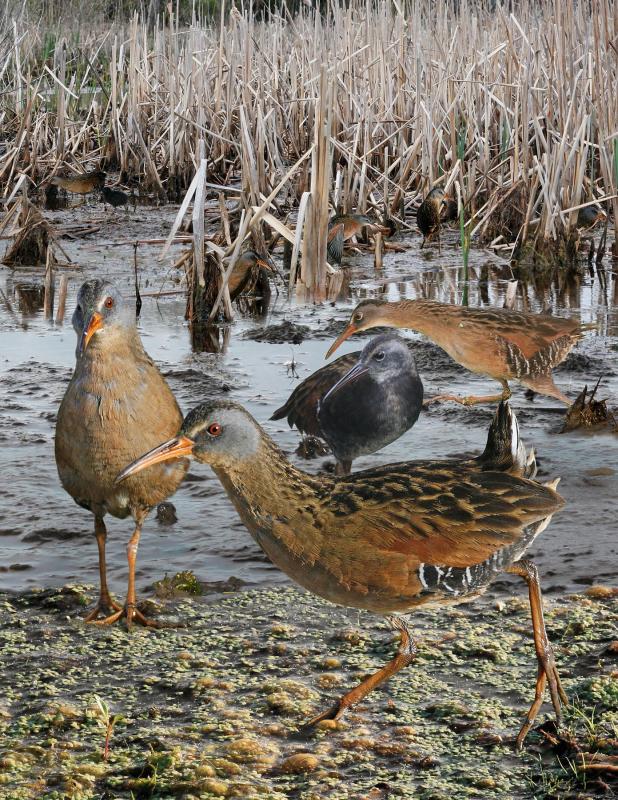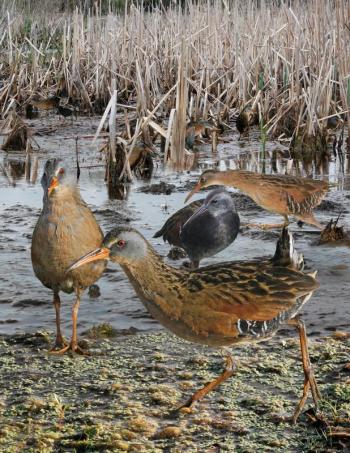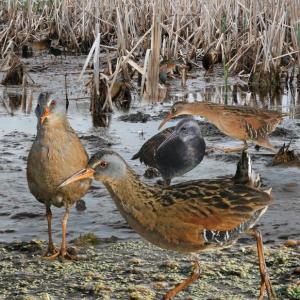Five Black Fluffballs at Our Favorite Local Marsh
We stopped at one of our favorite freshwater cattail marshes again this week as we often do. The marsh is only a few miles from where we live and has no name that we are aware of. We stop by when we have some time and just stand quietly by beside the car listening and watching the activity. On this last visit we were scanning the tops of the flattened cattails, the ripening, thickened seed heads sticking up here and there, still not fully brown and plump like they are in the fall. We were hoping to catch a glimpse of the three or so marsh wrens we could hear singing their loud, ratchety, repetitive songs from that thicket of cattails. The sweet, loose trill of a swamp sparrow occasionally floated out from the wetland. Our binoculars glued to our eyes, we perused the cattails over and over. Neither marsh wren nor swamp sparrow would bless us with a glimpse.
But a beaver’s broad head emerged from the water about 30 feet from us next to its bulky lodge, on top of which were now growing various plants including, we were surprised to see, several blossoming nightshades, with their purple and yellow flowers. As we observed the beaver, there emerged beyond it, from the cattails on one side of a narrow channel, a black ball of fluff on two legs. About the size of a baseball, the black fluffball gave a hop and disappeared into the vegetation on the other side of the narrow opening. Within seconds, it was followed by another. Then another. And another. And another, until eventually five of these black fluffballs had crossed.
We had just documented the successful nesting of a pair of Virginia rails!
Virginia rails are rather special birds. Superficially, their bodies resemble a small chicken in silhouette, with large feet and a short tail but with a rather long, thick bill. Most rails are secretive birds of wetlands where they are adept at staying hidden from the site of the prying eyes of lethal creatures and, to our frustration, harmless birders as well. Detecting rails is often only accomplished by hearing their songs and calls. But even that can be difficult because they are most often heard at night or, at best, at dawn and dusk.
We were lucky on a second count as a few minutes after seeing the five Virginia rail chicks hop across the channel, we heard the unmistakable grunting calls of an adult. Soon that sound was followed by a second adult bird grunting, and we were thrilled to catch sight of one of the adults fly across a wider channel not far from us and give us a quick view before it scuttled away.
By spending time quietly observing birds at places like this, we have been very fortunate to have seen many young birds over the past month or so. It is so exciting to watch the adult birds feeding the newly fledged chicks, the babies quivering their wings as they beg with open beaks. We’ve seen young crows, chickadees, nuthatches, robins, chipping sparrows, hairy and downy woodpeckers, northern flickers, and some very amusing young blue jays that explored the clothespins on our clothesline in the vain hope that they were edible.
These kinds of observations are particularly important for all of us to contribute to the Maine Bird Atlas project that we have written about in some of our past columns. The Maine Bird Atlas aims to map the distribution of the birds of Maine for the period 2018-2022. You can sign up at https://www.maine.gov/ifw/fish-wildlife/maine-bird-atlas/index.html, and you can send in your records through eBird at: https://ebird.org/atlasme/home.
Jeffrey V. Wells, Ph.D., is a Fellow of the Cornell Lab of Ornithology and Vice President of Boreal Conservation for National Audubon. Dr. Wells is one of the nation's leading bird experts and conservation biologists and author of the “Birder’s Conservation Handbook.” His grandfather, the late John Chase, was a columnist for the Boothbay Register for many years. Allison Childs Wells, formerly of the Cornell Lab of Ornithology, is a senior director at the Natural Resources Council of Maine, a nonprofit membership organization working statewide to protect the nature of Maine. Both are widely published natural history writers and are the authors of the popular book, “Maine’s Favorite Birds” (Tilbury House) and “Birds of Aruba, Bonaire, and Curaçao: A Site and Field Guide,” (Cornell University Press).
Event Date
Address
United States

























